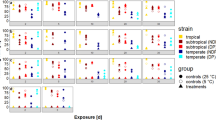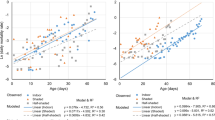Summary
Survival times of eggs under three humidity conditions (42%, 68%, 88% RH) were investigated among Aedes (Stegomyia) mosquitoes from temperate and tropical zones (5 species and 20 geographical strains). This subgenus tends to occupy small aquatic sites as larvae, where desiccation resistance of eggs is necessary during habitat drought. Interspecific comparison showed that the egg survival time was correlated with egg volume and dryness of source locality, and probably with habitat. Aedes aegypti is associated most with arid climate and human-disturbed habitats — its large eggs survived the longest periods at all humidities. Aedes albopictus ranges from tropics to temperate zones and inhabits both disturbed and forest habitats — its eggs were less desiccation-resistant than A. aegypti eggs. The survival times for forest species eggs (A. riversi, A. galloisi, A. flavopictus) were variable at high humidities but at the lowest humidity were consistently shorter than for eggs of A. aegypti and A. albopictus.
Similar content being viewed by others
References
Black WC, Rai KS, Turco BJ, Arroyo DC (1989) Laboratory study of competition between United States strains of Aedes albopictus and Aedes aegypti (Diptera: Culicidae). J Med Entomol 26:260–271
Bradshaw WE, Holzapfel CM (1988) Drought and the organization of tree-hole mosquito communities. Oecologia 74:507–514
Chan KL, Chan C, Ho BC (1971) Aedes aegypti (L.) and Aedes albopictus (Skuse) in Singapore City. 4. Competition between species. Bull WHO 44:643–649
Christophers SR (1960) Aedes aegypti (L.), the Yellow Fever Mosquito, its life history, bionomics and structure. Cambridge University Press, London
Clark AG, Doane WW (1983) Desiccation tolerance of the adipose 60 mutant of Drosophila melanogaster. Hereditas 99:165–175
Danks HV (1987) Insect dormancy: an ecological perspective. Biological Survey of Canada, National Museum of Natural Sciences, Ottawa
Denlinger DL (1986) Dormancy in tropical insects. Annu Rev Entomol 31:239–264
Eshita Y, Kurihara T (1979) Studies on the habitats of Aedes albopictus and Ae. riversi in the southwestern part of Japan. Jpn J Sanit Zool 30:181–185
Fontenille D, Rohdhain F (1989) Biology and distribution of Aedes albopictus and Aedes aegypti in Madagascar. J Am Mosq Control Assoc 5:219–225
Foo LC, Lim TW, Lee HL, Fang R (1985) Rainfall, abundance of Aedes aegypti and dengue infection in Selangor, Malaysia. Southeast Asian J Trop Med Pub Health 16:560–568
Gillett JD (1962) Resistance to desiccation in six strains of the Culex pipiens complex. Mosq News 22:342–345
Gubler DJ (1970) Comparison of reproductive potentials if Aedes (Stegomyia) albopictus Skuse and Aedes (Stegomyia) polynesiensis Marks. Mosq News 30:201–209
Hawley WA (1985) A high fecundity aedine: factors affecting egg production of the western treehole mosquito, Aedes sierrensis (Diptera: Culicidae). J Med Entomol 22:220–225
Hawley WA (1988) The biology of Aedes albopictus. J Am Mosq Control Assoc (Suppl) 4:1–39
Hien DS (1975) Biology of Aedes aegypti (L., 1762) and Aedes albopictus (Skuse, 1895) (Diptera, Culicidae). I. Resistance of eggs to low humidity. Acta Parasitol Pol 23:395–402
Ho BC, Adam B, Chew L (1989) Interspecific competition among Aedes aegypti, Ae. albopictus, and Ae. triseriatus (Diptera: Culicidae): larval development in mixed cultures. J Med Entomol 26:615–623
Hoffmann AA, Parsons PA (1989) An integrated approach to environmental stress tolerance and life-history variation: desiccation tolerance in Drosophila. Biol J Linn Soc 37:117–136
Hood WG, Tschinkel WR (1990) Desiccation resistance in arboreal and terrestrial ants. Physiol Entomol 15:23–35
Huang YM (1979) The subgenus Stegomyia of Aedes in the oriental region with keys to the species (Diptera: Culicidae). Contrib Am Entomol Inst (Ann Arbor). 15(6): 1–79
Imai C, Maeda O (1976) Several factors effecting on hatching of Aedes albopictus eggs. Jpn J Sanit Zool 27:367–372
Kingsolver JG (1979) Thermal and hydric aspects of environmental heterogeneity in the pitcher plant mosquito. Ecology 49:357–376
Kira T (1976) Terrestrial ecosystem. Kyoritsu, Tokyo
Linley JR (1989) Comparative fine structure of the eggs of Aedes albopictus, Ae. aegypti, and Ae. bahamensis (Diptera: Culicidae). J Med Entomol 26:510–521
Lounibos LP (1981) Habitat segregation among African treehole mosquitoes. Ecol Entomol 6:129–154
Machado-Allison CE, Craig GB Jr (1972) Geographic variation in resistance to desiccation in Aedes aegypti and A. atropalpus (Diptera: Culicidae). Ann Entomol Soc Am 65:542–547
Matsuo K, Yoshida Y, Lien JC (1974) Scanning electron microscopy of mosquitoes. II. The egg surface structure of 13 species of Aedes from Taiwan. J Med Entomol 11:179–188
Mattingly PF (1957) Genetical aspects of the Aedes aegypti problem I. Taxonomy and bionomics. Ann Trop Med Parasit 51:392–408
Miyagi I, Toma T (1980) Studies on the mosquitoes in Yaemama Islands, Japan 5. Notes on the mosquitoes collected in forest areas of Iriomotejima. Jpn J Sanit Zool 31:81–91
Miyagi I, Toma T, Iha S (1983) Studies on the mosquitoes in Yaemama Islands, Japan. 8. On the mosquitoes collected in Yonagunijima. Jpn J Sanit Zool 34:1–6
Mogi M (1990) Further notes on the northern distribution of Aedes (Stegomyia) riversi (Diptera: Culicidae). Mosq Syst 22:47–52
Mogi M, Khamboonruang C, Choochote W, Suwanpanit P (1988) Ovitrap surveys of dengue vector mosquitoes in Chiang Mai, northern Thailand: seasonal shifts in relative abundance of Aedes albopictus and Ae. aegypti. Med Vet Entomol 2:319–324
Munstermann LE, Wasmuth LM (1985) Aedes aegypti. In: Singh P, Moore RF (eds) Handbook of insect rearing, Vol. 2. Elservier, Amsterdam, pp 7–14
Nasci RS, Hare SG, Willis FC (1989) Interspecific mating between Louisiana strains of Aedes albopictus and Aedes aegypti in the field and laboratory. J Am Mosq Control Assoc 5:416–421
Parsons PA (1974) Genetics of resistance to environmental stresses in Drosophila populations. Annu Rev Genet 7:239–265
Persons PA (1981) Evolutionary ecology of Australian Drosophila: a species analysis. Evol Biol 14:297–350
Rai KS (1991) Aedes albopictus in the Americas. Annu Rev Entomol 36:459–484
Rai KS, Pashley DP, Munstermann LE (1982) Genetics of speciation in Aedes mosquitoes. In: Steiner WWM, Tabachnik WJ, Rai KS, Narang S (eds) Recent developments in the genetics of insect disease vectors. Stripes, Chicago, pp 84–129
SAS Institute (1985) SAS user's guide: statistics, version 5 edition. SAS Institute, Cary, North Carolina
Schultz GW (1989) Cemetery vase breeding of dengue vectors in Manila, Republic of the Philippines. J Mosq Control Assoc 5:508–513
Snedecor GW, Cochran WG (1967) Statistical methods. 6th ed. Iowa State University Press, Ames, Iowa
Tauber MJ, Tauber CA, Masaki S (1986) Seasonal adaptations of insects. Oxford University Press, New York
Tokyo Astronomical Observatory (1991) Rika-nenpyo (Chronological scientific tables). Maruzen, Tokyo
Toma T, Miyagi I (1981) Notes on the mosquitoes collected at forest areas in the northern part of Okinawajima, Ryukyu Islands, Japan. Jpn J Sanit Zool 32:271–279
Toma T, Miyagi I (1986) The mosquito fauna of the Ryukyu Archipelago with identification keys, pupal descriptions and notes on biology, medical importance and distribution. Mosq Syst 18:1–109
Trpis M (1970) A new bleaching and decalcifying method for general use in zoology. Can J Zool 48:892–893
Trpis M (1972) Dry season survival of Aedes aegypti eggs in various breeding sites in the Dar es Salaam area, Tanzania. Bull WHO 147:433–437
Author information
Authors and Affiliations
Rights and permissions
About this article
Cite this article
Sota, T., Mogi, M. Interspecific variation in desiccation survival time of Aedes (Stegomyia) mosquito eggs is correlated with habitat and egg size. Oecologia 90, 353–358 (1992). https://doi.org/10.1007/BF00317691
Received:
Accepted:
Issue Date:
DOI: https://doi.org/10.1007/BF00317691




